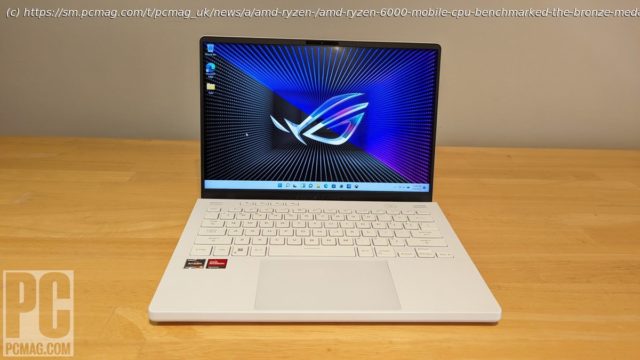AMD’s new Ryzen Zen 3+ laptop processors pack serious power but the competition is fierce. The Ryzen 9 6900HS clocks in behind Intel’s «Alder Lake» Core i9 and Apple’s M1…but not by much.
Just weeks after their unveiling at CES, AMD’s Ryzen 6000 Series mobile processors are poised to show up in retail laptops, challenging Intel’s latest 12th Generation («Alder Lake») mobile CPUs and Apple’s proprietary M1 processors with the most advanced AMD technology yet. The last couple of years have been marked by major architecture changes in Intel and Apple processors, which means that AMD stands out by sticking with the tried and true. With no differentiated Efficiency cores or Performance cores like on Intel’s latest laptop chips, AMD’s Ryzen 9 6000 laptop CPUs combine dozens of small enhancements and optimizations to deliver better power and efficiency across all eight of their cores. AMD dubs this iteration to its architecture «Zen 3+.» But that doesn’t mean that the latest AMD processors aren’t going to offer improved performance and power management. On the contrary, AMD has worked to squeeze more raw power out of these sixth-generation CPUs, which were code-named «Rembrandt» during development. (That’s in keeping with AMD’s recent CPU families being named after artists.) The company touts five layers of power optimization, ranging from the physical silicon to the system software. All are aimed at delivering next-generation capabilities without the need for a massive architecture change. AMD Ryzen 6000 Process Improvements: It’s 6nm’s Time to Shine With these new Ryzen 6000 processors for laptops, AMD has moved to a 6-nanometer (6nm) manufacturing process, which means more transistors on the chip. There are up to 13.1 billion transistors on the 210 square millimeters of silicon in the Ryzen 6000 series, up from the 10.7 billion available on the Ryzen 5000 line. We’ll be testing the Ryzen 9 6900HS below, third down in the new Ryzen 6000 stack, which comprises both high-power H-series and lower-power U-series CPUs… The Ryzen 6000 mobile lineup You can see more about the full new Ryzen 6000 mobile-chip lineup in our launch article from CES 2022. The new process doesn’t just allow the company to design smaller chips with more transistors. It means those parts deliver more efficient operation. Smaller sizes mean less power leakage, letting the new chips squeeze more processing muscle out of the same power levels. AMD claims a 30% increase in overall speed and performance over last year’s 7nm Ryzen 5000 series. AMD Ryzen 9 6900HS processor details Intel, meanwhile, has stopped using the nanometer metric altogether to describe the process technology for its chips, and both Apple and Intel have embraced new technologies that make the simple measurement less of a clear-cut performance indicator. That said, because AMD is using an updated version of existing architecture, the move to 6nm does signal improvements in power and performance over its previous 7nm chips. The Focus: Fine-Tuning for Power Savings While the overall chip architecture iterates on the existing Zen 3 model, the microarchitecture of individual cores and the power-delivery systems have all gotten improvements. The broad details look nearly identical to last year’s Zen 3 line, with the Ryzen 9 5000 offering eight full cores with 16 processing threads, backed by a 16MB L3 cache and 128-bit-wide memory. Details of AMD’s five-layer optimization strategy But other things have changed, like the addition of RDNA 2, bringing more of AMD’s powerful graphics capabilities to systems that aren’t equipped with a dedicated GPU. With 12 compute units on the chip, the graphics improvements alone are impressive—you can even get ray tracing without a discrete graphics solution. Aside from graphics, the overall layout of the mobile CPU is largely unchanged, hence the Zen 3+ moniker, indicating an iterative update to last year’s Zen 3 chips. There are some changes, such as an expanded array of memory controllers. They now use a dual-channel design with two subchannels, offering the same 128 bits, but broken up into four x32 channels for DDR5 and LPDDR5 support. The other notable change to the chip’s topology is the addition of a Microsoft Pluton processor (for current Windows security requirements) and a more advanced display controller, which adds support for advanced display-output standards, such as HDMI 2.1 and DisplayPort 2, on up to four screens. Functional changes ramp up the efficiency, as well. The chip can transition to deeper sleep states with faster sleep and wake times. Initialization times are sped up by skipping the power-down/power-up process used by the L3 cache, while a new «dirtiness counter» monitors that cache to determine when it needs to be cycled down to recover. Our Ryzen 6000 test model: The 2022 Asus ROG Zephyrus G14 But it’s more than just chip-level changes. New sleep states also let the processor scale back the power, even dropping cores into momentary sleep states as needed, to provide small power savings throughout operational use. For example, stop scrolling on a web page, and the associated process will downshift until it’s needed again. Even the display capabilities have gotten this granular power management, by introducing the ability to refresh portions of the display instead of the full screen with every change. Instead of refreshing the empty margins of a document, the processor can now tell the display to refresh only the portions with text, or sections of a webpage instead of the full screen. AMD says that it has implemented 50 of these new power optimizations, having an impact on everything from fan noise to battery life. The result is faster wake times and enhanced allocation of memory bandwidth and processing threads. Hardware-accelerated low-power modes let you enjoy uninterrupted use while letting your laptop keep power draw to a minimum. Finally, the new CPUs offer a broader continuum of power and efficiency. Instead of standardized power modes that let you opt for either quiet, energy-efficient operation or a performance-focused mode that throttles up the cooling fans and chews through the battery, the power management offered on the new Ryzen 9 is more granular. It takes into account several internal inputs, like laptop skin temperature, power trajectory, firmware performance indicators, and workload type, then adjusts the balance dynamically. As with the architecture tweaks, these are subtle-yet-sophisticated refinements. It all adds up to a CPU that can deliver more processing power while consuming less battery power. It’s a very different approach than the two-tier processing solutions embraced by Apple and Intel, but it’s a compelling one. And while the promise of better battery life and brawny processing muscle is still there, the question lingers: Can the Ryzen 6000 line deliver well enough to take on Intel and Apple? AMD Ryzen 6000: Stepping Up With a New Platform AMD has also upgraded the feature set for its latest CPUs, offering a full platform refresh for 2022. The Zen 3+ processors support new features, notably USB 4 and PCI Express Gen 4, a full upgrade to DDR5 and LPDDR5 memory, and improved wireless connectivity with Wi-Fi 6 and Wi-Fi 6E support, along with Bluetooth 5.2. One interesting note: At the time of our discussions with AMD, the chips weren’t yet certified for Thunderbolt 4, but with 40GBps bandwidth on USB 4, it should meet the spec requirements handily, and AMD expects full certification soon. AMD Ryzen 9 6000 series features And, as expected for a company that’s as much about graphics as it is CPU power, the new Ryzen chips offer improved display support.
Домой
United States
USA — software AMD Ryzen 6000 Mobile CPU Benchmarked: The Bronze Medal Ain't Bad






